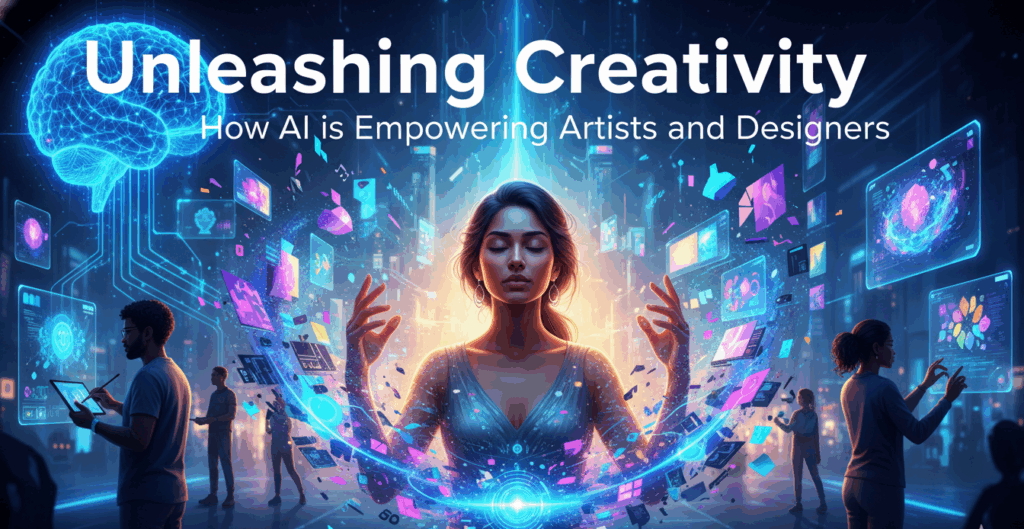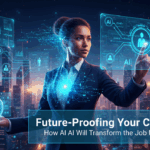For centuries, creativity has been considered a uniquely human domain, a testament to our imagination, intuition, and emotional depth. The idea of machines creating art or designing elegant solutions once belonged purely to science fiction. However, the rapid advancements in Artificial Intelligence, particularly in generative AI, are dismantling these long-held notions. Far from replacing human artists and designers, AI is emerging as an incredibly powerful tool, acting as a collaborator, muse, and efficiency enhancer, ultimately unleashing new frontiers of human creativity.
This paradigm shift is not without its debates and challenges, but the reality is that AI is already transforming how creative professionals work. By automating tedious tasks, generating novel ideas, and providing entirely new mediums for expression, AI is empowering artists and designers to push boundaries, explore concepts previously unimaginable, and bring their visions to life with unprecedented speed and scale.
The Evolution of AI in Creativity: From Automation to Generation
AI’s role in creative fields has evolved significantly over time:
1. Early Tools and Automation (Augmenting Efficiency)
Initially, AI’s contribution was primarily in automating repetitive or complex technical tasks, making the creative process more efficient.
-
Smart Editing Tools: Early AI-powered features in software like Adobe Photoshop or Lightroom (e.g., automatic red-eye removal, content-aware fill, smart selections) helped artists refine their work faster.
-
Algorithmic Design: Generating variations of patterns, layouts, or color palettes based on specific rules, often seen in industrial design or architectural tools.
-
Personalized Content Delivery: AI optimizing how media (music, videos) is recommended to users, influencing the consumption side of creativity.
2. Machine Learning for Analysis and Prediction (Informing Creativity)
As Machine Learning matured, AI began to provide deeper insights, informing creative decisions.
-
Style Transfer: Algorithms that could apply the artistic style of one image onto another (e.g., turning a photo into a Van Gogh-like painting).
-
Predictive Analytics in Design: AI analyzing user data to predict design trends, optimize user interfaces (UI/UX) for better engagement, or identify successful aesthetic elements.
-
Music Analysis: AI identifying musical patterns, moods, or genre characteristics to assist composers or music producers.
3. Generative AI (Co-creating and Inspiring Creativity)
The true revolution for artists and designers came with the rise of generative AI, especially in the last few years. Models like DALL-E, Midjourney, Stable Diffusion, and advanced Large Language Models (LLMs) like ChatGPT have brought AI into the core of the creative act.
-
Text-to-Image Generation: Users can describe an image using natural language (“a futuristic city at sunset, cyberpunk style, highly detailed”), and the AI generates multiple unique visual interpretations.
-
Text-to-Art Generation: Producing diverse artistic styles, from photorealistic images to abstract paintings, illustrations, and 3D renders.
-
Text-to-3D Models/Video: Emerging capabilities where AI generates entire 3D assets or video clips from textual prompts.
-
Music Composition: AI generating melodies, harmonies, or even full orchestral pieces based on genre, mood, or instrumental specifications.
-
Content Generation: AI assisting with writing scripts, poetry, marketing copy, or even entire narratives, freeing human writers to focus on overarching themes and refinement.
How AI is Empowering Artists and Designers
The capabilities of generative AI are not about replacing human creativity but about augmenting it in several profound ways.
1. Ideation and Brainstorming: The Infinite Muse
One of the biggest hurdles in any creative process is often staring at a blank canvas or page. AI can act as a tireless brainstorming partner.
-
Rapid Concept Generation: Artists can use AI to quickly generate hundreds of visual concepts for a project in minutes. Need ideas for a creature design? A character’s outfit? A landscape? AI can provide diverse interpretations, helping to overcome creative blocks.
-
Exploring Variations: Instead of manually sketching dozens of variations of a logo or character, designers can prompt AI to generate variations based on specific parameters, accelerating the ideation phase.
-
Mood Board Creation: AI can instantly generate visual assets that contribute to a specific mood or aesthetic for a project, saving hours of searching for reference images.
-
Style Exploration: Artists can experiment with different artistic styles (e.g., “impressionistic,” “cyberpunk,” “watercolor”) on their concepts, allowing for rapid iteration and discovery of new aesthetics.
2. Automation of Tedious and Repetitive Tasks: Freeing Up Time for True Creativity
Many creative fields involve repetitive, time-consuming tasks that can drain an artist’s energy. AI is excellent at automating these.
-
Image Manipulation and Editing: AI can quickly remove backgrounds, upscale images, colorize black-and-white photos, or perform complex retouching tasks with remarkable efficiency.
-
Asset Generation: For game developers or animators, AI can generate countless textures, environmental assets (trees, rocks), or even character variations based on a few prompts, significantly speeding up production pipelines.
-
Layout and Composition: In graphic design, AI can suggest optimal layouts for posters, websites, or brochures, ensuring aesthetic balance and functional hierarchy.
-
Version Control and Organization: AI can help categorize, tag, and manage vast libraries of creative assets, making it easier for teams to find and reuse elements.
3. Breaking Creative Barriers: Exploring Uncharted Territories
AI enables artists and designers to venture into creative domains they might not have had the skills or resources for previously.
-
Cross-Disciplinary Exploration: A visual artist with no musical background can use AI to generate accompanying soundtracks for their animations, or a writer can create visuals for their stories without needing drawing skills.
-
Access to Complex Tools: AI simplifies the use of complex 3D modeling or animation software by allowing users to generate elements through natural language, lowering the barrier to entry.
-
Personalized Content at Scale: For independent creators, AI can help generate vast amounts of personalized content (e.g., unique NFTs, custom digital art for individual clients) that would be impossible to create manually.
-
New Mediums: AI itself is becoming a new artistic medium, with “prompt engineering” evolving into an art form where the skill lies in crafting precise and evocative text descriptions to guide the AI’s generation.
4. Personalization and Customization: Tailoring for Audiences
AI can help creators understand and cater to their audiences on an unprecedented level.
-
Targeted Design: AI can analyze user preferences to generate design variations that resonate with specific demographics or individual users (e.g., personalized website layouts, custom product designs).
-
A/B Testing and Optimization: AI can rapidly generate and test multiple design variations to see which performs best, providing data-driven insights for designers.
-
Adaptive Content: For interactive experiences or games, AI can dynamically generate content (dialogue, environments, challenges) that adapts to the user’s choices or skill level.
5. Education and Skill Development: A Powerful Learning Tool
AI can also serve as an educational aid for aspiring and seasoned creatives.
-
Skill Augmentation: An artist struggling with perspective can use AI to generate accurate perspective grids or reference images. A writer can use AI to get feedback on grammar, style, or plot development.
-
Learning New Techniques: By analyzing existing art, AI can extract stylistic elements or techniques, providing insights for artists looking to learn new approaches.
-
Interactive Tutorials: AI-powered tutors can offer personalized guidance on creative software or artistic principles.
Challenges and Ethical Considerations
While AI offers immense empowerment, its integration into creative fields also brings significant challenges and ethical dilemmas.
1. Copyright and Ownership
-
Training Data Concerns: Many generative AI models are trained on vast datasets of existing art, raising questions about whether artists whose work was used in training should be compensated or credited.
-
AI-Generated Works: Who owns the copyright to art generated by AI? The prompt engineer? The AI developer? The legal frameworks are still catching up.
-
Plagiarism/Stylistic Appropriation: The ability of AI to mimic specific artistic styles raises concerns about plagiarism and the devaluation of unique human artistic contributions.
2. The Definition of Art and Creativity
-
Human vs. Machine Creativity: Does AI truly “create,” or merely remix and extrapolate from existing data? This philosophical debate impacts how AI-generated art is perceived and valued.
-
Devaluation of Human Skill: Some worry that the ease of AI art generation could devalue the years of skill and effort required for traditional artistic mastery.
3. Bias and Representation
-
Bias in Training Data: If AI is trained on data that primarily reflects certain demographics or styles, it may perpetuate those biases, leading to a lack of diversity in its outputs.
-
Stereotype Amplification: AI could inadvertently reinforce stereotypes if not carefully designed and managed.
4. Job Displacement for Routine Creative Tasks
-
Automation of Entry-Level Work: Tasks like generating stock images, basic graphic design for advertisements, or simple content writing could see significant automation, impacting entry-level creative jobs.
-
Shift in Skill Sets: The demand will shift from executing routine tasks to managing AI, prompt engineering, and providing high-level creative direction.
5. Ethical Use and Misinformation
-
Deepfakes and Synthetic Media: The ability to generate highly realistic images and videos can be used to create misleading or harmful content, eroding trust in visual media.
-
Lack of Attribution: The ease of AI generation can lead to a flood of unattributed content, making it harder to track origins and respect intellectual property.
The Future: Human-AI Collaboration at Its Peak
The future of creativity in the age of AI is not about humans versus machines, but about human-AI collaboration. Artists and designers who embrace AI as a tool, understand its capabilities and limitations, and learn to direct it effectively will be the most successful.
-
The AI-Augmented Artist/Designer: Professionals will leverage AI to offload mundane tasks, accelerate ideation, explore variations, and execute complex elements, allowing them to focus on the core creative vision, storytelling, and emotional resonance that only a human can provide.
-
New Creative Roles: We will see the emergence of roles like “AI Art Director,” “Prompt Engineer,” “Generative Artist,” “AI Experience Designer,” and “Algorithmic Storyteller.”
-
Ethical Frameworks for Creative AI: The industry will need to establish clear ethical guidelines, licensing models, and attribution standards for AI-generated and AI-assisted creative works.
-
AI as a Personal Assistant: Imagine an AI that understands your unique artistic style, knows your preferences, and can anticipate your needs, acting as a true creative partner.
-
Unlocking Mass Customization: AI will allow designers to create hyper-personalized products and experiences for individual consumers at scale, previously impossible.
Conclusion: A Renaissance of Human Imagination
AI is not here to steal human creativity but to amplify it. By providing an unparalleled capacity for ideation, automation, and exploration, AI tools are liberating artists and designers from technical constraints and repetitive labor, allowing them to focus on the truly human aspects of creation: vision, emotion, storytelling, and innovative problem-solving.
While the ethical and philosophical debates around AI and creativity are vital and ongoing, the undeniable reality is that a new era of artistic expression has dawned. Those who learn to harness the power of AI responsibly, viewing it as a powerful extension of their creative faculties, will be the pioneers of a new renaissance, pushing the boundaries of imagination and forging entirely new forms of art and design for the 21st century and beyond. The canvas just got infinitely larger, and the palette endlessly richer, thanks to the intelligence we’ve built.


